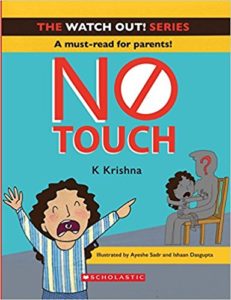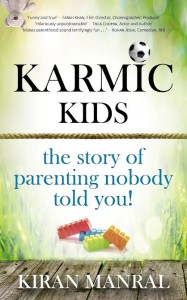“No Touch” A picture book on child sexual abuse ( CSA)
 Not a day goes by without the morning newspapers reporting the horrendous sexual attacks upon children. It is frightening and deeply disturbing. In a manner of speaking CSA ( child sexual abuse) has replaced the news about dowry deaths which used to fill the papers in the 1980s.
Not a day goes by without the morning newspapers reporting the horrendous sexual attacks upon children. It is frightening and deeply disturbing. In a manner of speaking CSA ( child sexual abuse) has replaced the news about dowry deaths which used to fill the papers in the 1980s.
It becomes extremely difficult to discuss child sexual abuse particularly in a society like India where any conversation remotely linked to sex is considered moral taboo. It is not uncommon to hear of young couples getting married and clueless about how babies are born! In such a scenario teaching a child to recognise and articulate uncomfortable scenarios which are probably in the purview of CSA becomes challenging. Hence a picture book like No Touch published by Scholastic India is relevant and useful.
In fact an innovative way of getting this book read has been by having copies of the book dropped off by book fairies on the Delhi metro.
Let's fight child abuse together with this book ?
Dropped at Seelampur?#booksonthedelhimetro #delhimetro #childabuse@IndiaScholastic pic.twitter.com/5PzOCZsCXi— Books On Delhi Metro (@booksonthemetro) August 3, 2017
Child sexual abuse is absolutely horrific and what is truly alarming is the perpetrators are mostly known to the children abused. There have been many concerted campaigns such as this animated video on child sexual abuse made in English and Hindi by CHILDLINEIndia. In 2014 noted filmmaker Pankaj Butalia published Dark Room: Child Sexuality in India with the hope to open this conversation outside of the specialized, academic circles. Another brilliant attempt was made by Scholastic India author Ken Spillman in his short story “A bubble of shared knowing”. After the December 2013 dastardly act of raping a young girl in Delhi the conversations about child sexual abuse and rape opened up and for the first time these filtered into public spaces and collective consciousnesses. As a result the case of writer and rape survivor Sohaila Abdulali who had been gang-raped in the 1980s began to be discussed once more. In fact she was brave enough to write about the incident in an NYT article “I Was Wounded; My Honor Wasn’t” ( 7 Jan 2013). A few months later she co-authored a forceful article in the Guardian asking for children to be made aware of rape and sexual assault, the discourse must be brought home. ( “To protect our children, we must talk to them about rape” 26 April 2013).
No Touch a picture book is a step in the right direction. The book needs to be read, shared and disseminated widely. These difficult conversations must be had in every household and schools.
No Touch published by Scholastic India. Hb. 2017
3 August 2017



